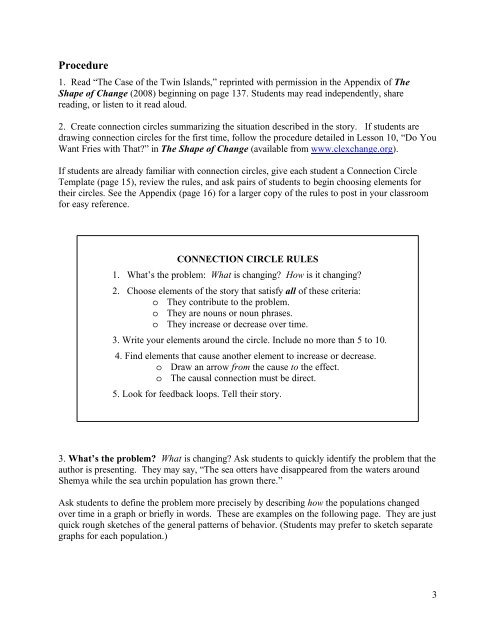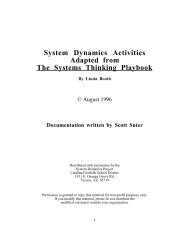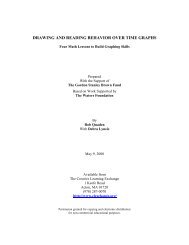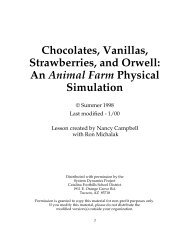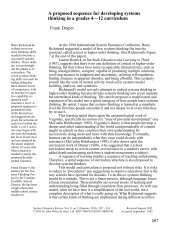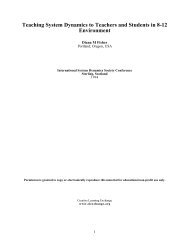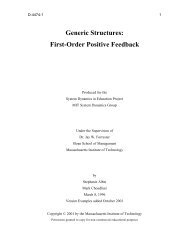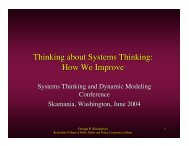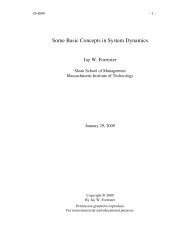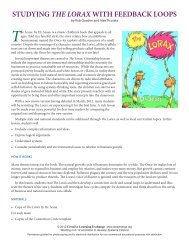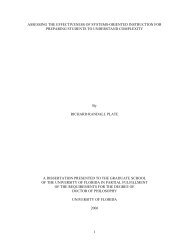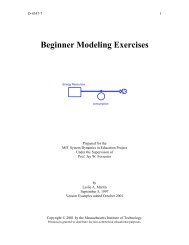Keystone Species in an Ecosystem Using Connection Circles to Tell ...
Keystone Species in an Ecosystem Using Connection Circles to Tell ...
Keystone Species in an Ecosystem Using Connection Circles to Tell ...
Create successful ePaper yourself
Turn your PDF publications into a flip-book with our unique Google optimized e-Paper software.
Procedure1. Read “The Case of the Tw<strong>in</strong> Isl<strong>an</strong>ds,” repr<strong>in</strong>ted with permission <strong>in</strong> the Appendix of TheShape of Ch<strong>an</strong>ge (2008) beg<strong>in</strong>n<strong>in</strong>g on page 137. Students may read <strong>in</strong>dependently, shareread<strong>in</strong>g, or listen <strong>to</strong> it read aloud.2. Create connection circles summariz<strong>in</strong>g the situation described <strong>in</strong> the s<strong>to</strong>ry. If students aredraw<strong>in</strong>g connection circles for the first time, follow the procedure detailed <strong>in</strong> Lesson 10, “Do YouW<strong>an</strong>t Fries with That?” <strong>in</strong> The Shape of Ch<strong>an</strong>ge (available from www.clexch<strong>an</strong>ge.org).If students are already familiar with connection circles, give each student a <strong>Connection</strong> CircleTemplate (page 15), review the rules, <strong>an</strong>d ask pairs of students <strong>to</strong> beg<strong>in</strong> choos<strong>in</strong>g elements fortheir circles. See the Appendix (page 16) for a larger copy of the rules <strong>to</strong> post <strong>in</strong> your classroomfor easy reference.CONNECTION CIRCLE RULES1. What’s the problem: What is ch<strong>an</strong>g<strong>in</strong>g? How is it ch<strong>an</strong>g<strong>in</strong>g?2. Choose elements of the s<strong>to</strong>ry that satisfy all of these criteria:o They contribute <strong>to</strong> the problem.o They are nouns or noun phrases.o They <strong>in</strong>crease or decrease over time.3. Write your elements around the circle. Include no more th<strong>an</strong> 5 <strong>to</strong> 10.4. F<strong>in</strong>d elements that cause <strong>an</strong>other element <strong>to</strong> <strong>in</strong>crease or decrease.o Draw <strong>an</strong> arrow from the cause <strong>to</strong> the effect.o The causal connection must be direct.5. Look for feedback loops. <strong>Tell</strong> their s<strong>to</strong>ry.3. What’s the problem? What is ch<strong>an</strong>g<strong>in</strong>g? Ask students <strong>to</strong> quickly identify the problem that theauthor is present<strong>in</strong>g. They may say, “The sea otters have disappeared from the waters aroundShemya while the sea urch<strong>in</strong> population has grown there.”Ask students <strong>to</strong> def<strong>in</strong>e the problem more precisely by describ<strong>in</strong>g how the populations ch<strong>an</strong>gedover time <strong>in</strong> a graph or briefly <strong>in</strong> words. These are examples on the follow<strong>in</strong>g page. They are justquick rough sketches of the general patterns of behavior. (Students may prefer <strong>to</strong> sketch separategraphs for each population.)3


